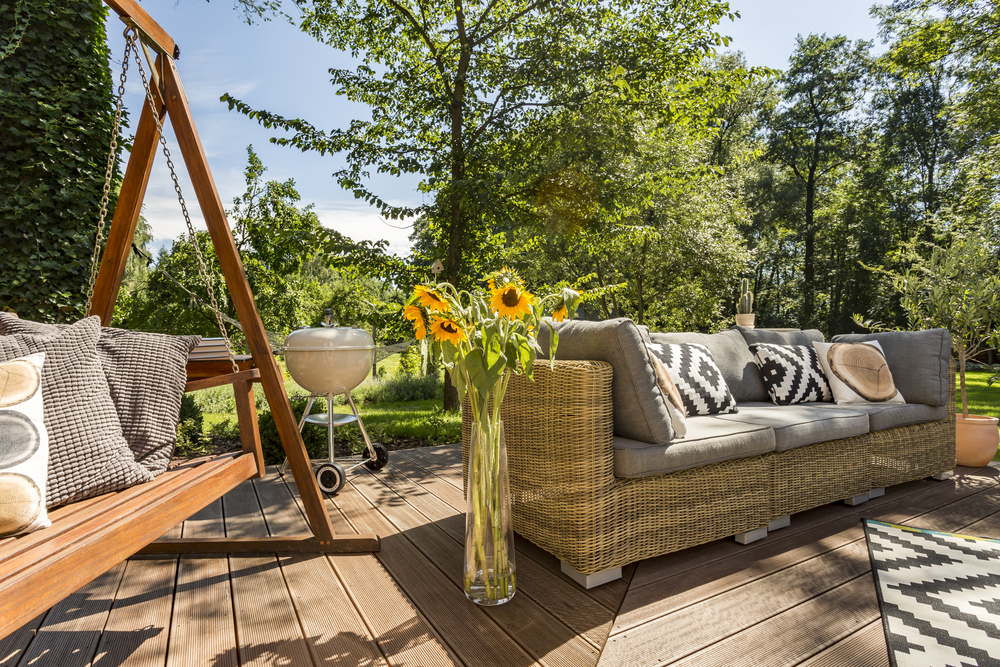Finding the Right Patio Sofa for Your Backyard

The perfect patio sofa is one that’s comfortable, pretty, and durable–in that order. Comfortable because of what all sofas are for; pretty before durable because you’d never want to be stuck long-term with an item you don’t like to see; durable because there are plenty of other things to spend couch-sized money on!
The question of shape and size is an individual thing. It depends on the area your patio sofa is destined for. The other individual, case-by-case question is that of material. Rattan/wicker, metal, and wood all have their pros and cons which should be weighed against several factors, especially climate. In this article, we’ll go through a brief introduction to each.
Patio Sectional Sofa
Every patio sectional sofa comes with the benefit of versatility. You can always separate the pieces to create additional conversation spots or just an extra spacious look. Many come with ottomans too, which can usually double as additional seating, and sometimes can even serve as temporary or makeshift coffee tables.
Since “sectional” means only that the sofa comes in sections, patio sectional sofas can be found in all materials and styles. If you think you might want to go with a patio sectional sofa, make sure to measure the space where you anticipate placing it; will there be room for all the pieces if they’re together? If they’re separated? Don’t forget to leave room to walk!
Wicker Patio Sofa
Wicker is a weaving style (not a material) that’s been used at least as far back as ancient Egypt. In the 1850s, it started a good 100-year-or-more run of megapopularity in the US and Europe, partly because wicker was thought to be more sanitary than upholstery. This is probably why you almost inevitably thought of your grandmother when you saw that we were going to be discussing it in this article. There are some fantastic modern wicker patio sofas, some of which you would have never seen on Grandma’s patio!
Wicker is usually made of rattan or a synthetic imitation of it. Although the natural stuff does better outdoors than, say, an indoor couch, you still may want to keep your wicker patio sofa under a canopy of some sort and off of grass. Its synthetic counterpart, however, should have an easier time resisting mildew and other outdoor damage.
Metal Patio Sofa
You have quite the list of options if you’re thinking about a metal patio sofa. Aluminum–hollow or not–steel, and iron are the most common metals found framing patio furniture.
Aluminum is ubiquitous because it’s light and doesn’t rust, but the hollow kind (also called “extruded”) dents easily and can go airborne in a good wind. Look into cast aluminum before deciding on an aluminum patio sofa.
Wrought iron is the classic material for that “formal” look. It’s incredibly heavy which means it’s practically bulletproof, but also hard to move. Once a wrought iron patio sofa gets placed, you’re going to want to leave it there.
Steel can be a sort of best-of-both-worlds situation, boasting the strength of iron without being so heavy. Steel is usually treated with an anti-rust coating, which means that any chip or scratch should be resealed before it allows any rust to take hold.
Wood Patio Sofa
There are even more types of wood patio sofas to choose from than metal ones. Teak, cedar, and white oak are among the most popular. Pine is more susceptible to rot and moisture damage, so it’s used more for indoor pieces. If you find a pine patio sofa you love, make sure you verify that it’s been treated with a sealant and be ready to reseal it at least once a year.
Teak, cedar, and white oak are popular for wood patio sofas because they contain natural oils that repel bugs and moisture. Red oak is softer and more susceptible than white to all sorts of damage. Teak is sort of the “king of outdoor furniture”, but cedar can last for 30 years or more and white oak was the wood used to build the USS Constitution, which was actually nicknamed Old Ironsides.
Don’t Forget Your Cushion Covers!
Now, especially if you end up with a heavy patio sofa whose frame can rust or rot, you’ll want to invest in a patio sofa cover. These are handy little (or big) items, usually made of polyester or vinyl, that you can toss over your patio sofa like a poncho and tighten to protect it from at least mild wind and precipitation. They’re not foolproof–consider a storage shed for the winter–but they sure can help.
Of course, your patio sofa cover will have less work to do if you’re using water-resistant cushion covers. The rule of thumb is to cover everything, maybe redundantly, for those long, wet and cold months of no use, especially if it’s not possible to move your patio sofa indoors somewhere.
Best of Luck Finding Your Perfect Patio Sofa!
Remember–wicker, metal, and wood patio sofas alike have their pros and cons, especially depending on the climate you live in. Natural rattan wicker is best suited for covered areas in mild climates but synthetic wicker is usually heartier. Aluminum, especially of the cast variety, may be the best option for a metal patio sofa, though iron and steel can’t be rejected out of hand. And teak, along with cedar and white oak (not red oak) are some of the best bets for a wood patio sofa.
Finding your perfect patio sofa takes time and patience. At least the appearance of the cushions doesn’t have to foil your efforts since you can replace their covers so easily! Best of luck on the hunt, and have fun!

